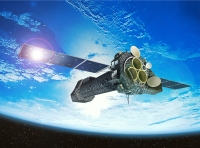|
January 10, 2005
|
| Science
News Release 1-2005: The observation, made with ESA's XMM-Newton observatory, marks the first time scientists could trace individual blobs of shredded matter on a complete journey around a black hole. This provides a crucial measurement that has long been missing from black hole studies: an orbital period. Knowing this, scientists can measure black hole mass and other characteristics that have long eluded them. Dr Jane Turner (NASA Goddard Space Flight Center, Greenbelt, USA and University of Maryland Baltimore County, USA) presents this result today at a press conference at the American Astronomical Society in San Diego together with Dr Lance Miller (University of Oxford, United Kingdom). "For years we have seen only the general commotion caused by massive black holes, that is, a terrific outpouring of light," said Turner. "We could not track the specifics. Now, with XMM-Newton, we can filter through all that light and find patterns that reveal information about black holes never seen before in such clarity." For the full release visit the ESA Science Media Centre
|
|
| < Previous Article | Next Article > |
